Pearson BTEC: Managing a Computing Project on AI in Manufacturing
VerifiedAdded on 2022/09/08
|20
|5765
|19
Project
AI Summary
This project report investigates the integration of Artificial Intelligence (AI) into the manufacturing industry to achieve a competitive edge. It discusses the primary drivers of AI adoption in manufacturing, its aims, and objectives, and examines Lighthouse Factories as examples of successful AI implementation. The report covers project management principles, including goal setting, communication, risk assessment, and the development of a project management plan with stages such as project initiation, planning, and execution. The project aims to determine how AI improves product quality, inventory accuracy, and transforms manufacturing activities like predictive maintenance and visual inspection. It also explores AI's role in streamlining supply chains and boosting yield rates through predictive analytics, offering a roadmap for industries and researchers looking to implement Industrial AI.
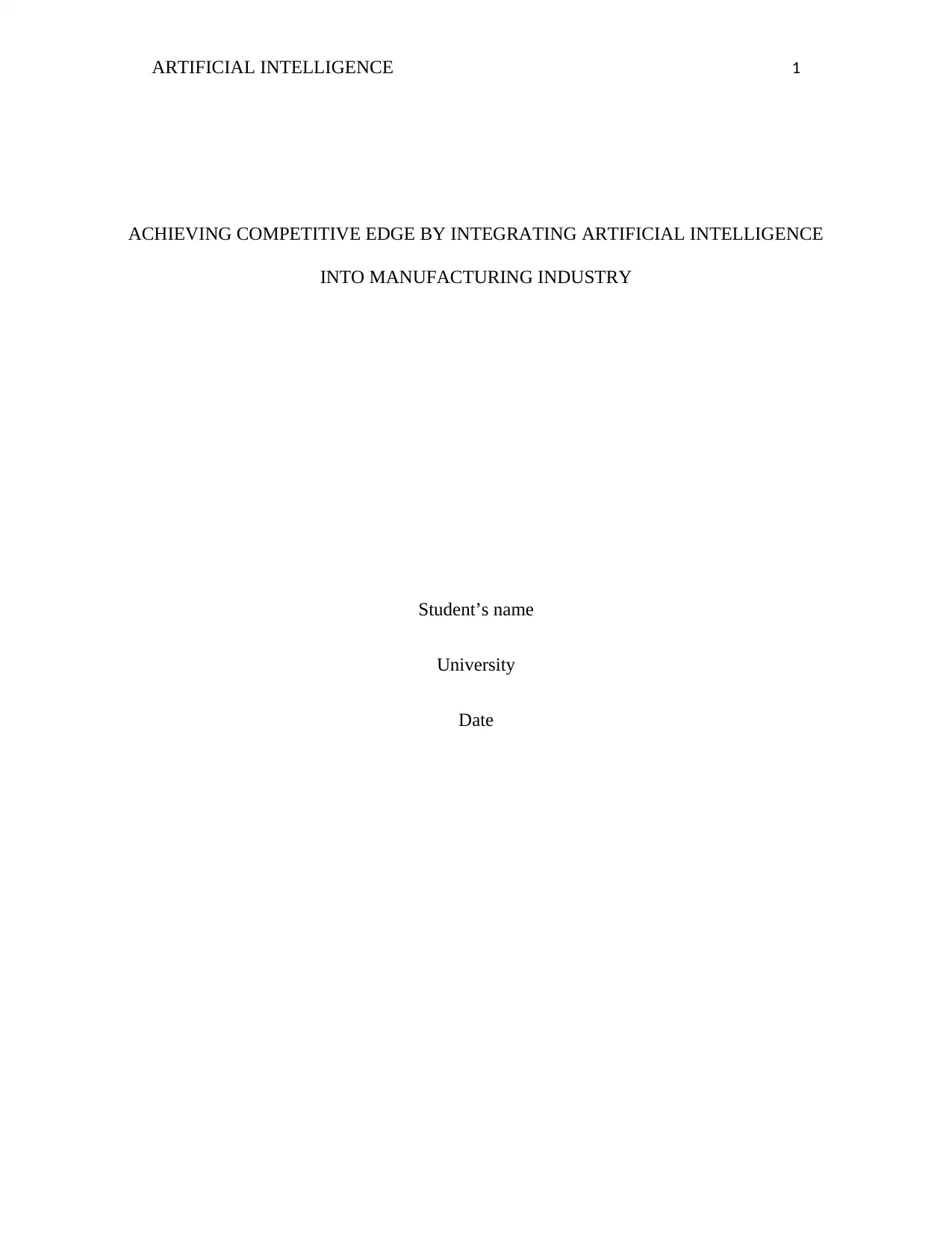
ARTIFICIAL INTELLIGENCE 1
ACHIEVING COMPETITIVE EDGE BY INTEGRATING ARTIFICIAL INTELLIGENCE
INTO MANUFACTURING INDUSTRY
Student’s name
University
Date
ACHIEVING COMPETITIVE EDGE BY INTEGRATING ARTIFICIAL INTELLIGENCE
INTO MANUFACTURING INDUSTRY
Student’s name
University
Date
Paraphrase This Document
Need a fresh take? Get an instant paraphrase of this document with our AI Paraphraser
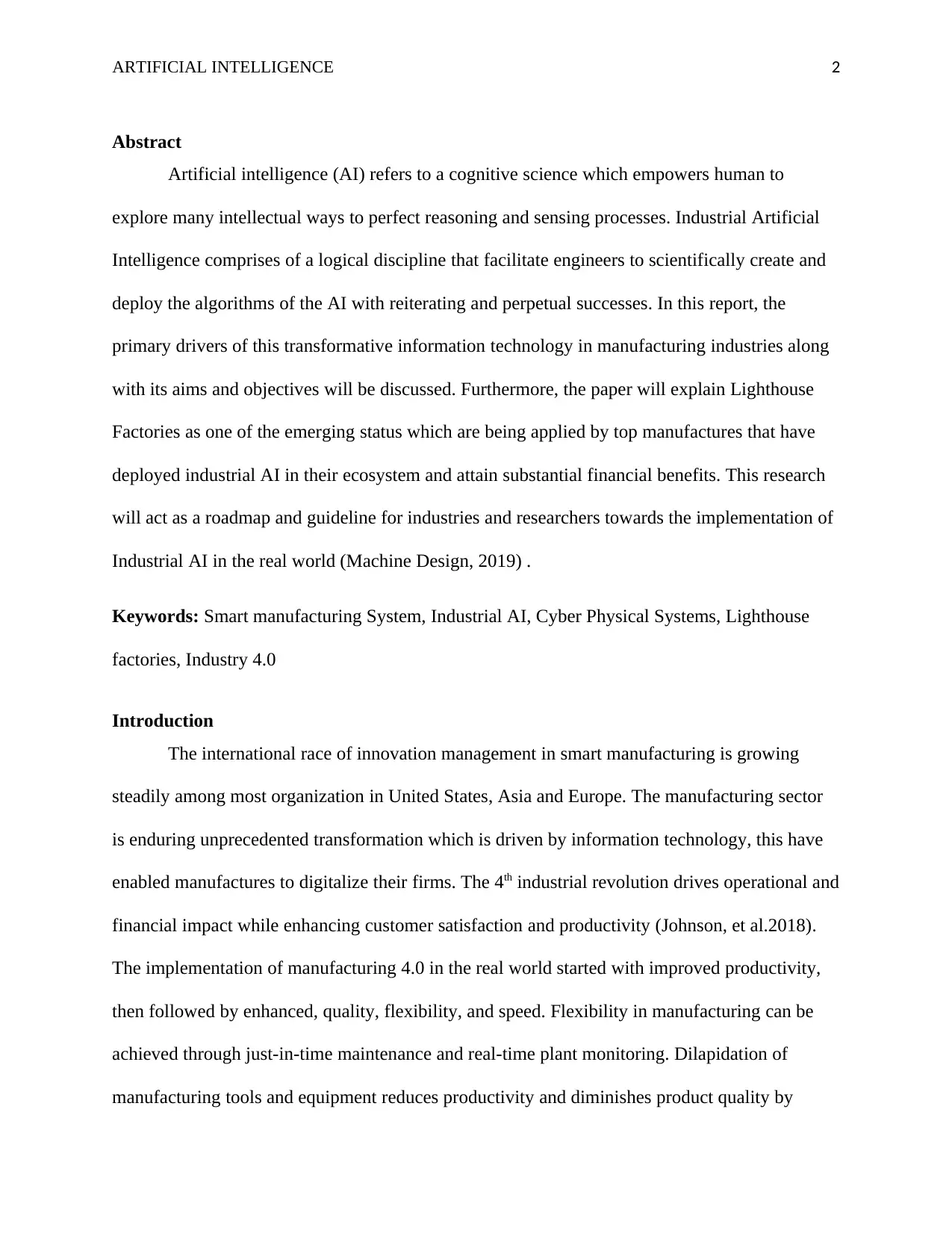
ARTIFICIAL INTELLIGENCE 2
Abstract
Artificial intelligence (AI) refers to a cognitive science which empowers human to
explore many intellectual ways to perfect reasoning and sensing processes. Industrial Artificial
Intelligence comprises of a logical discipline that facilitate engineers to scientifically create and
deploy the algorithms of the AI with reiterating and perpetual successes. In this report, the
primary drivers of this transformative information technology in manufacturing industries along
with its aims and objectives will be discussed. Furthermore, the paper will explain Lighthouse
Factories as one of the emerging status which are being applied by top manufactures that have
deployed industrial AI in their ecosystem and attain substantial financial benefits. This research
will act as a roadmap and guideline for industries and researchers towards the implementation of
Industrial AI in the real world (Machine Design, 2019) .
Keywords: Smart manufacturing System, Industrial AI, Cyber Physical Systems, Lighthouse
factories, Industry 4.0
Introduction
The international race of innovation management in smart manufacturing is growing
steadily among most organization in United States, Asia and Europe. The manufacturing sector
is enduring unprecedented transformation which is driven by information technology, this have
enabled manufactures to digitalize their firms. The 4th industrial revolution drives operational and
financial impact while enhancing customer satisfaction and productivity (Johnson, et al.2018).
The implementation of manufacturing 4.0 in the real world started with improved productivity,
then followed by enhanced, quality, flexibility, and speed. Flexibility in manufacturing can be
achieved through just-in-time maintenance and real-time plant monitoring. Dilapidation of
manufacturing tools and equipment reduces productivity and diminishes product quality by
Abstract
Artificial intelligence (AI) refers to a cognitive science which empowers human to
explore many intellectual ways to perfect reasoning and sensing processes. Industrial Artificial
Intelligence comprises of a logical discipline that facilitate engineers to scientifically create and
deploy the algorithms of the AI with reiterating and perpetual successes. In this report, the
primary drivers of this transformative information technology in manufacturing industries along
with its aims and objectives will be discussed. Furthermore, the paper will explain Lighthouse
Factories as one of the emerging status which are being applied by top manufactures that have
deployed industrial AI in their ecosystem and attain substantial financial benefits. This research
will act as a roadmap and guideline for industries and researchers towards the implementation of
Industrial AI in the real world (Machine Design, 2019) .
Keywords: Smart manufacturing System, Industrial AI, Cyber Physical Systems, Lighthouse
factories, Industry 4.0
Introduction
The international race of innovation management in smart manufacturing is growing
steadily among most organization in United States, Asia and Europe. The manufacturing sector
is enduring unprecedented transformation which is driven by information technology, this have
enabled manufactures to digitalize their firms. The 4th industrial revolution drives operational and
financial impact while enhancing customer satisfaction and productivity (Johnson, et al.2018).
The implementation of manufacturing 4.0 in the real world started with improved productivity,
then followed by enhanced, quality, flexibility, and speed. Flexibility in manufacturing can be
achieved through just-in-time maintenance and real-time plant monitoring. Dilapidation of
manufacturing tools and equipment reduces productivity and diminishes product quality by
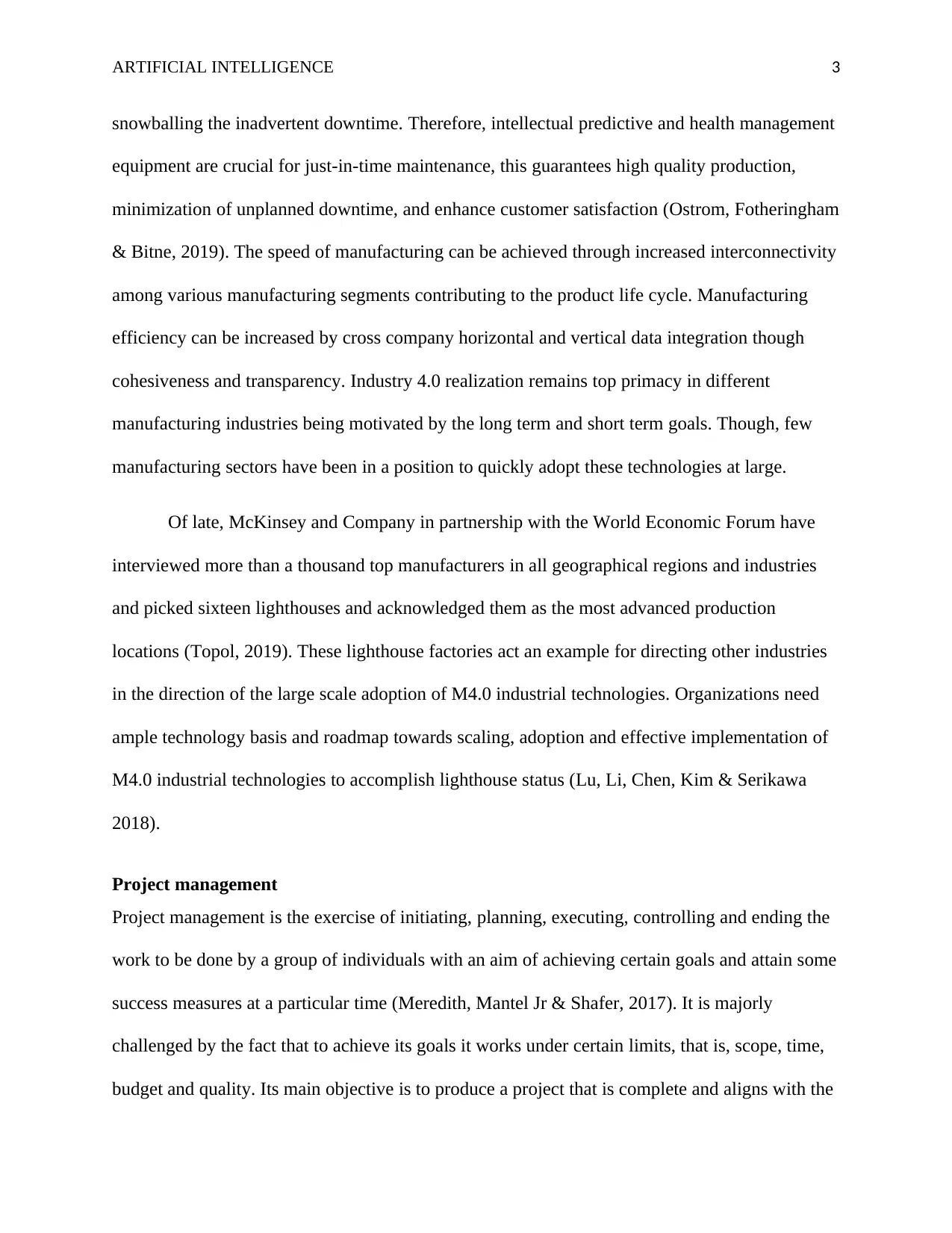
ARTIFICIAL INTELLIGENCE 3
snowballing the inadvertent downtime. Therefore, intellectual predictive and health management
equipment are crucial for just-in-time maintenance, this guarantees high quality production,
minimization of unplanned downtime, and enhance customer satisfaction (Ostrom, Fotheringham
& Bitne, 2019). The speed of manufacturing can be achieved through increased interconnectivity
among various manufacturing segments contributing to the product life cycle. Manufacturing
efficiency can be increased by cross company horizontal and vertical data integration though
cohesiveness and transparency. Industry 4.0 realization remains top primacy in different
manufacturing industries being motivated by the long term and short term goals. Though, few
manufacturing sectors have been in a position to quickly adopt these technologies at large.
Of late, McKinsey and Company in partnership with the World Economic Forum have
interviewed more than a thousand top manufacturers in all geographical regions and industries
and picked sixteen lighthouses and acknowledged them as the most advanced production
locations (Topol, 2019). These lighthouse factories act an example for directing other industries
in the direction of the large scale adoption of M4.0 industrial technologies. Organizations need
ample technology basis and roadmap towards scaling, adoption and effective implementation of
M4.0 industrial technologies to accomplish lighthouse status (Lu, Li, Chen, Kim & Serikawa
2018).
Project management
Project management is the exercise of initiating, planning, executing, controlling and ending the
work to be done by a group of individuals with an aim of achieving certain goals and attain some
success measures at a particular time (Meredith, Mantel Jr & Shafer, 2017). It is majorly
challenged by the fact that to achieve its goals it works under certain limits, that is, scope, time,
budget and quality. Its main objective is to produce a project that is complete and aligns with the
snowballing the inadvertent downtime. Therefore, intellectual predictive and health management
equipment are crucial for just-in-time maintenance, this guarantees high quality production,
minimization of unplanned downtime, and enhance customer satisfaction (Ostrom, Fotheringham
& Bitne, 2019). The speed of manufacturing can be achieved through increased interconnectivity
among various manufacturing segments contributing to the product life cycle. Manufacturing
efficiency can be increased by cross company horizontal and vertical data integration though
cohesiveness and transparency. Industry 4.0 realization remains top primacy in different
manufacturing industries being motivated by the long term and short term goals. Though, few
manufacturing sectors have been in a position to quickly adopt these technologies at large.
Of late, McKinsey and Company in partnership with the World Economic Forum have
interviewed more than a thousand top manufacturers in all geographical regions and industries
and picked sixteen lighthouses and acknowledged them as the most advanced production
locations (Topol, 2019). These lighthouse factories act an example for directing other industries
in the direction of the large scale adoption of M4.0 industrial technologies. Organizations need
ample technology basis and roadmap towards scaling, adoption and effective implementation of
M4.0 industrial technologies to accomplish lighthouse status (Lu, Li, Chen, Kim & Serikawa
2018).
Project management
Project management is the exercise of initiating, planning, executing, controlling and ending the
work to be done by a group of individuals with an aim of achieving certain goals and attain some
success measures at a particular time (Meredith, Mantel Jr & Shafer, 2017). It is majorly
challenged by the fact that to achieve its goals it works under certain limits, that is, scope, time,
budget and quality. Its main objective is to produce a project that is complete and aligns with the
⊘ This is a preview!⊘
Do you want full access?
Subscribe today to unlock all pages.

Trusted by 1+ million students worldwide
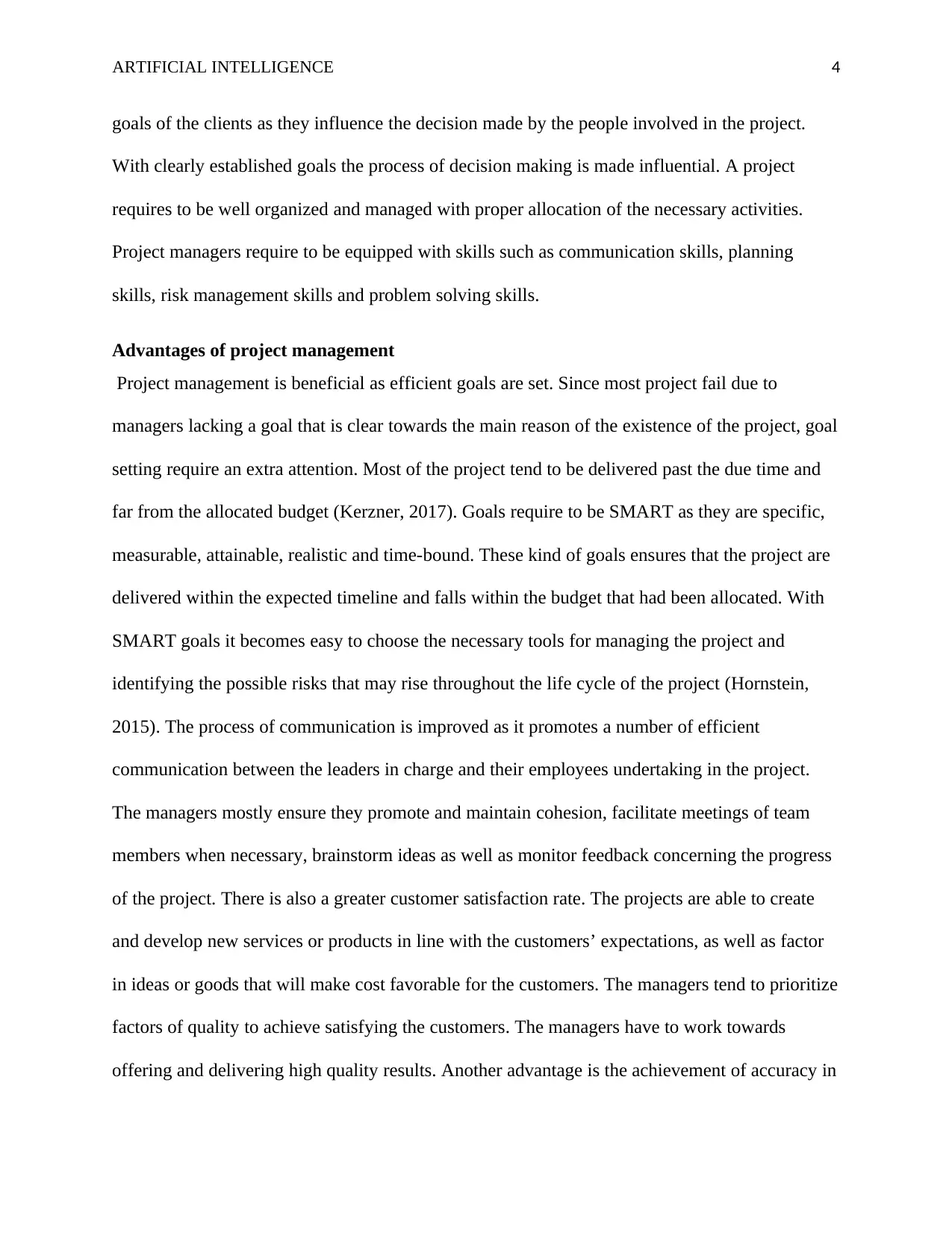
ARTIFICIAL INTELLIGENCE 4
goals of the clients as they influence the decision made by the people involved in the project.
With clearly established goals the process of decision making is made influential. A project
requires to be well organized and managed with proper allocation of the necessary activities.
Project managers require to be equipped with skills such as communication skills, planning
skills, risk management skills and problem solving skills.
Advantages of project management
Project management is beneficial as efficient goals are set. Since most project fail due to
managers lacking a goal that is clear towards the main reason of the existence of the project, goal
setting require an extra attention. Most of the project tend to be delivered past the due time and
far from the allocated budget (Kerzner, 2017). Goals require to be SMART as they are specific,
measurable, attainable, realistic and time-bound. These kind of goals ensures that the project are
delivered within the expected timeline and falls within the budget that had been allocated. With
SMART goals it becomes easy to choose the necessary tools for managing the project and
identifying the possible risks that may rise throughout the life cycle of the project (Hornstein,
2015). The process of communication is improved as it promotes a number of efficient
communication between the leaders in charge and their employees undertaking in the project.
The managers mostly ensure they promote and maintain cohesion, facilitate meetings of team
members when necessary, brainstorm ideas as well as monitor feedback concerning the progress
of the project. There is also a greater customer satisfaction rate. The projects are able to create
and develop new services or products in line with the customers’ expectations, as well as factor
in ideas or goods that will make cost favorable for the customers. The managers tend to prioritize
factors of quality to achieve satisfying the customers. The managers have to work towards
offering and delivering high quality results. Another advantage is the achievement of accuracy in
goals of the clients as they influence the decision made by the people involved in the project.
With clearly established goals the process of decision making is made influential. A project
requires to be well organized and managed with proper allocation of the necessary activities.
Project managers require to be equipped with skills such as communication skills, planning
skills, risk management skills and problem solving skills.
Advantages of project management
Project management is beneficial as efficient goals are set. Since most project fail due to
managers lacking a goal that is clear towards the main reason of the existence of the project, goal
setting require an extra attention. Most of the project tend to be delivered past the due time and
far from the allocated budget (Kerzner, 2017). Goals require to be SMART as they are specific,
measurable, attainable, realistic and time-bound. These kind of goals ensures that the project are
delivered within the expected timeline and falls within the budget that had been allocated. With
SMART goals it becomes easy to choose the necessary tools for managing the project and
identifying the possible risks that may rise throughout the life cycle of the project (Hornstein,
2015). The process of communication is improved as it promotes a number of efficient
communication between the leaders in charge and their employees undertaking in the project.
The managers mostly ensure they promote and maintain cohesion, facilitate meetings of team
members when necessary, brainstorm ideas as well as monitor feedback concerning the progress
of the project. There is also a greater customer satisfaction rate. The projects are able to create
and develop new services or products in line with the customers’ expectations, as well as factor
in ideas or goods that will make cost favorable for the customers. The managers tend to prioritize
factors of quality to achieve satisfying the customers. The managers have to work towards
offering and delivering high quality results. Another advantage is the achievement of accuracy in
Paraphrase This Document
Need a fresh take? Get an instant paraphrase of this document with our AI Paraphraser
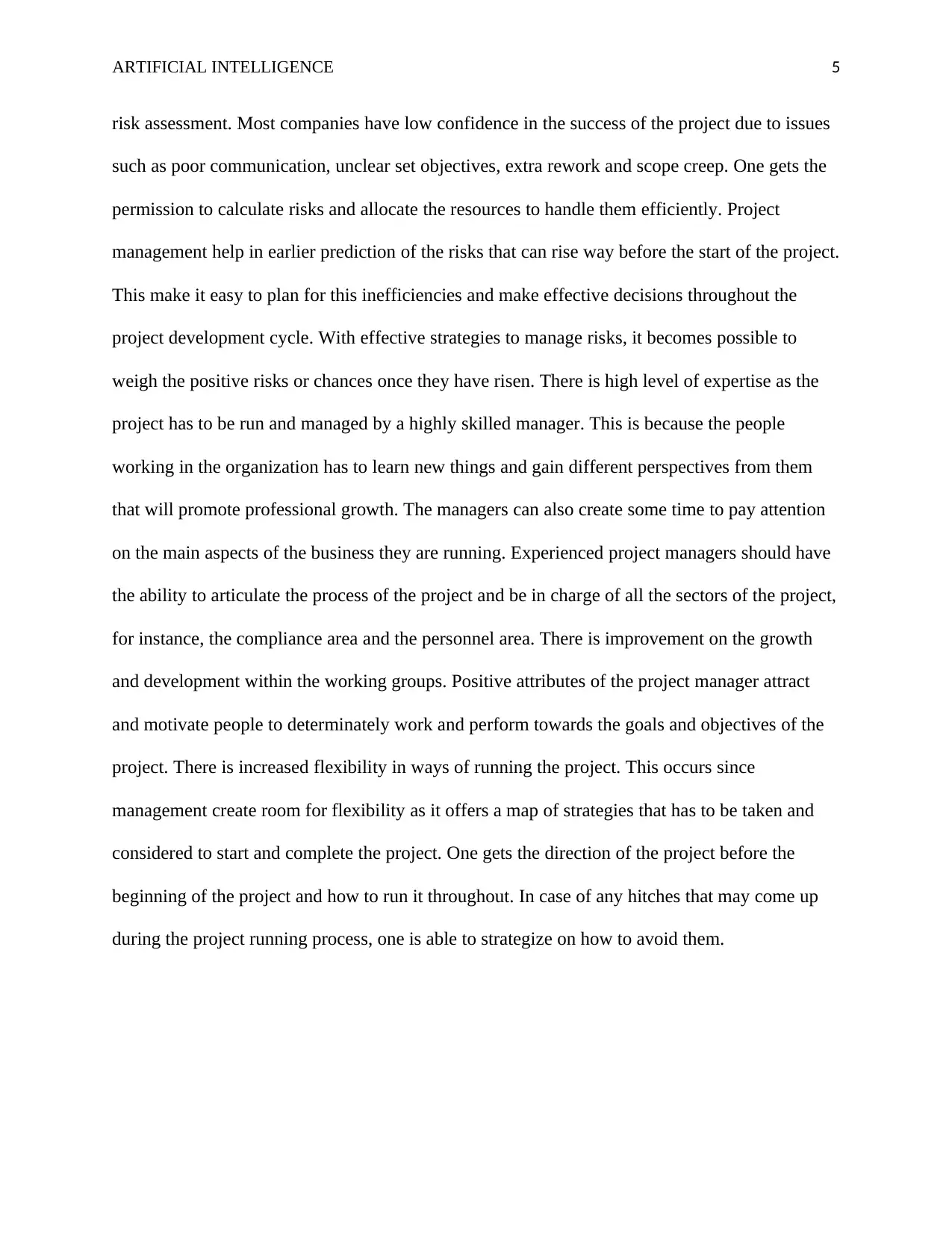
ARTIFICIAL INTELLIGENCE 5
risk assessment. Most companies have low confidence in the success of the project due to issues
such as poor communication, unclear set objectives, extra rework and scope creep. One gets the
permission to calculate risks and allocate the resources to handle them efficiently. Project
management help in earlier prediction of the risks that can rise way before the start of the project.
This make it easy to plan for this inefficiencies and make effective decisions throughout the
project development cycle. With effective strategies to manage risks, it becomes possible to
weigh the positive risks or chances once they have risen. There is high level of expertise as the
project has to be run and managed by a highly skilled manager. This is because the people
working in the organization has to learn new things and gain different perspectives from them
that will promote professional growth. The managers can also create some time to pay attention
on the main aspects of the business they are running. Experienced project managers should have
the ability to articulate the process of the project and be in charge of all the sectors of the project,
for instance, the compliance area and the personnel area. There is improvement on the growth
and development within the working groups. Positive attributes of the project manager attract
and motivate people to determinately work and perform towards the goals and objectives of the
project. There is increased flexibility in ways of running the project. This occurs since
management create room for flexibility as it offers a map of strategies that has to be taken and
considered to start and complete the project. One gets the direction of the project before the
beginning of the project and how to run it throughout. In case of any hitches that may come up
during the project running process, one is able to strategize on how to avoid them.
risk assessment. Most companies have low confidence in the success of the project due to issues
such as poor communication, unclear set objectives, extra rework and scope creep. One gets the
permission to calculate risks and allocate the resources to handle them efficiently. Project
management help in earlier prediction of the risks that can rise way before the start of the project.
This make it easy to plan for this inefficiencies and make effective decisions throughout the
project development cycle. With effective strategies to manage risks, it becomes possible to
weigh the positive risks or chances once they have risen. There is high level of expertise as the
project has to be run and managed by a highly skilled manager. This is because the people
working in the organization has to learn new things and gain different perspectives from them
that will promote professional growth. The managers can also create some time to pay attention
on the main aspects of the business they are running. Experienced project managers should have
the ability to articulate the process of the project and be in charge of all the sectors of the project,
for instance, the compliance area and the personnel area. There is improvement on the growth
and development within the working groups. Positive attributes of the project manager attract
and motivate people to determinately work and perform towards the goals and objectives of the
project. There is increased flexibility in ways of running the project. This occurs since
management create room for flexibility as it offers a map of strategies that has to be taken and
considered to start and complete the project. One gets the direction of the project before the
beginning of the project and how to run it throughout. In case of any hitches that may come up
during the project running process, one is able to strategize on how to avoid them.
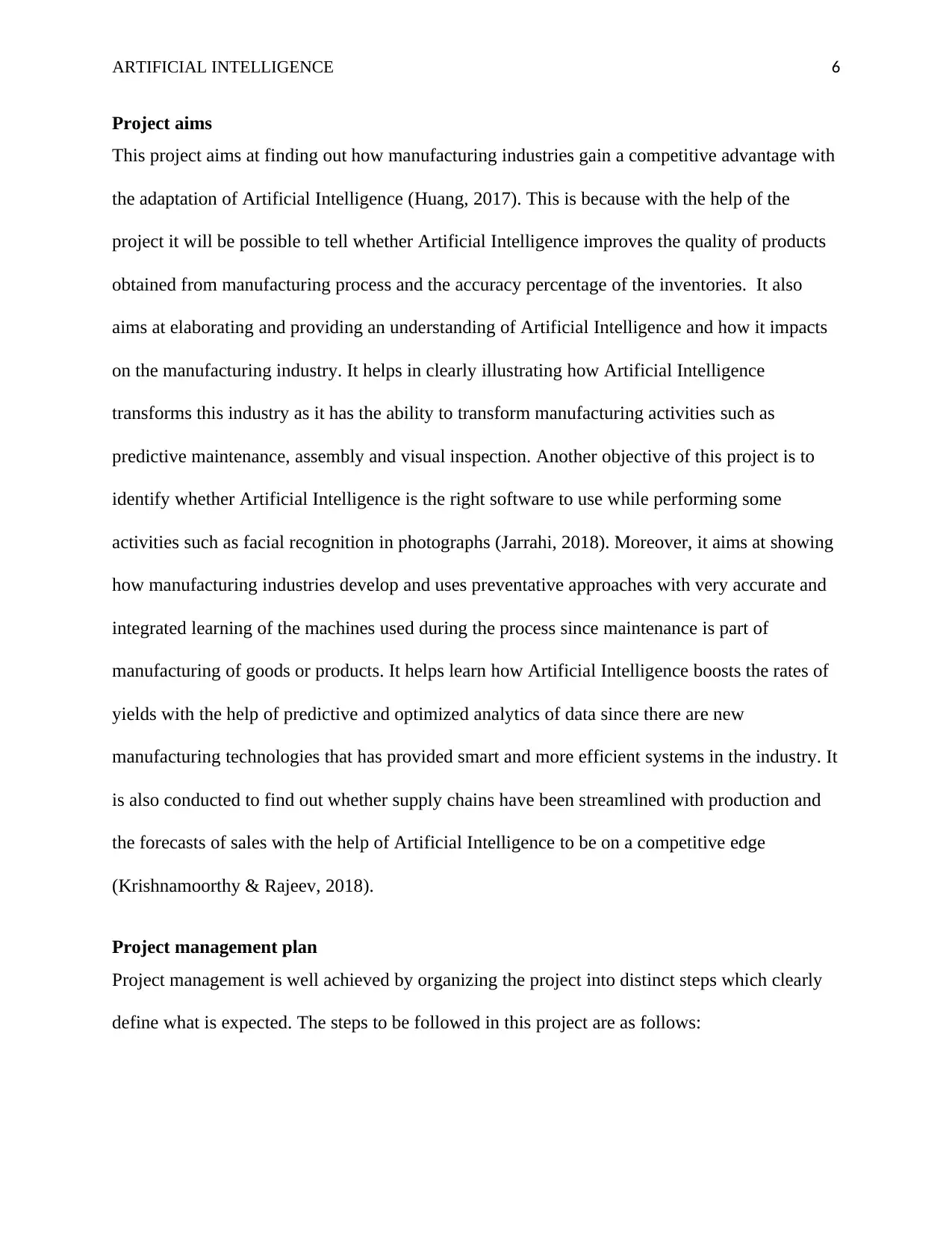
ARTIFICIAL INTELLIGENCE 6
Project aims
This project aims at finding out how manufacturing industries gain a competitive advantage with
the adaptation of Artificial Intelligence (Huang, 2017). This is because with the help of the
project it will be possible to tell whether Artificial Intelligence improves the quality of products
obtained from manufacturing process and the accuracy percentage of the inventories. It also
aims at elaborating and providing an understanding of Artificial Intelligence and how it impacts
on the manufacturing industry. It helps in clearly illustrating how Artificial Intelligence
transforms this industry as it has the ability to transform manufacturing activities such as
predictive maintenance, assembly and visual inspection. Another objective of this project is to
identify whether Artificial Intelligence is the right software to use while performing some
activities such as facial recognition in photographs (Jarrahi, 2018). Moreover, it aims at showing
how manufacturing industries develop and uses preventative approaches with very accurate and
integrated learning of the machines used during the process since maintenance is part of
manufacturing of goods or products. It helps learn how Artificial Intelligence boosts the rates of
yields with the help of predictive and optimized analytics of data since there are new
manufacturing technologies that has provided smart and more efficient systems in the industry. It
is also conducted to find out whether supply chains have been streamlined with production and
the forecasts of sales with the help of Artificial Intelligence to be on a competitive edge
(Krishnamoorthy & Rajeev, 2018).
Project management plan
Project management is well achieved by organizing the project into distinct steps which clearly
define what is expected. The steps to be followed in this project are as follows:
Project aims
This project aims at finding out how manufacturing industries gain a competitive advantage with
the adaptation of Artificial Intelligence (Huang, 2017). This is because with the help of the
project it will be possible to tell whether Artificial Intelligence improves the quality of products
obtained from manufacturing process and the accuracy percentage of the inventories. It also
aims at elaborating and providing an understanding of Artificial Intelligence and how it impacts
on the manufacturing industry. It helps in clearly illustrating how Artificial Intelligence
transforms this industry as it has the ability to transform manufacturing activities such as
predictive maintenance, assembly and visual inspection. Another objective of this project is to
identify whether Artificial Intelligence is the right software to use while performing some
activities such as facial recognition in photographs (Jarrahi, 2018). Moreover, it aims at showing
how manufacturing industries develop and uses preventative approaches with very accurate and
integrated learning of the machines used during the process since maintenance is part of
manufacturing of goods or products. It helps learn how Artificial Intelligence boosts the rates of
yields with the help of predictive and optimized analytics of data since there are new
manufacturing technologies that has provided smart and more efficient systems in the industry. It
is also conducted to find out whether supply chains have been streamlined with production and
the forecasts of sales with the help of Artificial Intelligence to be on a competitive edge
(Krishnamoorthy & Rajeev, 2018).
Project management plan
Project management is well achieved by organizing the project into distinct steps which clearly
define what is expected. The steps to be followed in this project are as follows:
⊘ This is a preview!⊘
Do you want full access?
Subscribe today to unlock all pages.

Trusted by 1+ million students worldwide
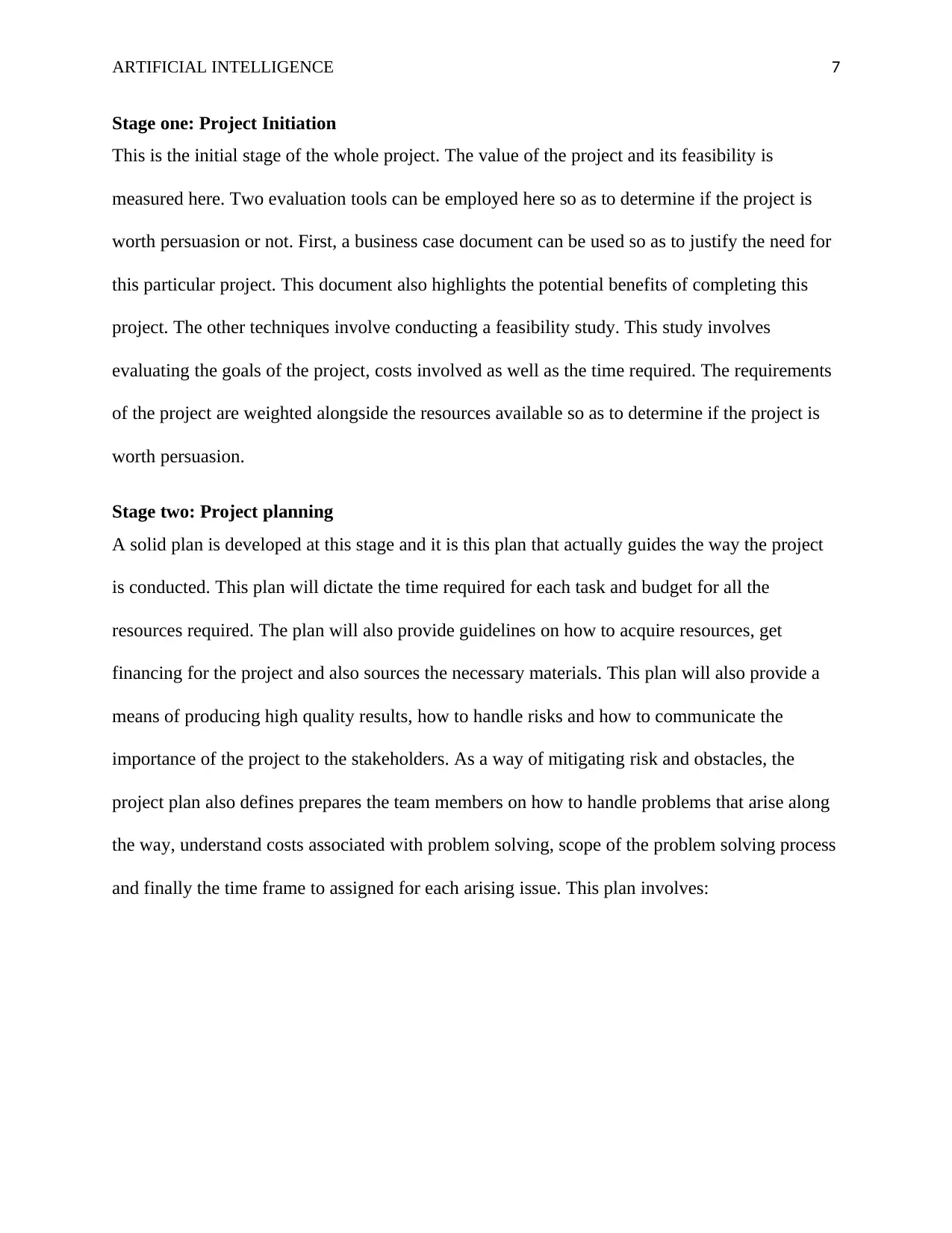
ARTIFICIAL INTELLIGENCE 7
Stage one: Project Initiation
This is the initial stage of the whole project. The value of the project and its feasibility is
measured here. Two evaluation tools can be employed here so as to determine if the project is
worth persuasion or not. First, a business case document can be used so as to justify the need for
this particular project. This document also highlights the potential benefits of completing this
project. The other techniques involve conducting a feasibility study. This study involves
evaluating the goals of the project, costs involved as well as the time required. The requirements
of the project are weighted alongside the resources available so as to determine if the project is
worth persuasion.
Stage two: Project planning
A solid plan is developed at this stage and it is this plan that actually guides the way the project
is conducted. This plan will dictate the time required for each task and budget for all the
resources required. The plan will also provide guidelines on how to acquire resources, get
financing for the project and also sources the necessary materials. This plan will also provide a
means of producing high quality results, how to handle risks and how to communicate the
importance of the project to the stakeholders. As a way of mitigating risk and obstacles, the
project plan also defines prepares the team members on how to handle problems that arise along
the way, understand costs associated with problem solving, scope of the problem solving process
and finally the time frame to assigned for each arising issue. This plan involves:
Stage one: Project Initiation
This is the initial stage of the whole project. The value of the project and its feasibility is
measured here. Two evaluation tools can be employed here so as to determine if the project is
worth persuasion or not. First, a business case document can be used so as to justify the need for
this particular project. This document also highlights the potential benefits of completing this
project. The other techniques involve conducting a feasibility study. This study involves
evaluating the goals of the project, costs involved as well as the time required. The requirements
of the project are weighted alongside the resources available so as to determine if the project is
worth persuasion.
Stage two: Project planning
A solid plan is developed at this stage and it is this plan that actually guides the way the project
is conducted. This plan will dictate the time required for each task and budget for all the
resources required. The plan will also provide guidelines on how to acquire resources, get
financing for the project and also sources the necessary materials. This plan will also provide a
means of producing high quality results, how to handle risks and how to communicate the
importance of the project to the stakeholders. As a way of mitigating risk and obstacles, the
project plan also defines prepares the team members on how to handle problems that arise along
the way, understand costs associated with problem solving, scope of the problem solving process
and finally the time frame to assigned for each arising issue. This plan involves:
Paraphrase This Document
Need a fresh take? Get an instant paraphrase of this document with our AI Paraphraser
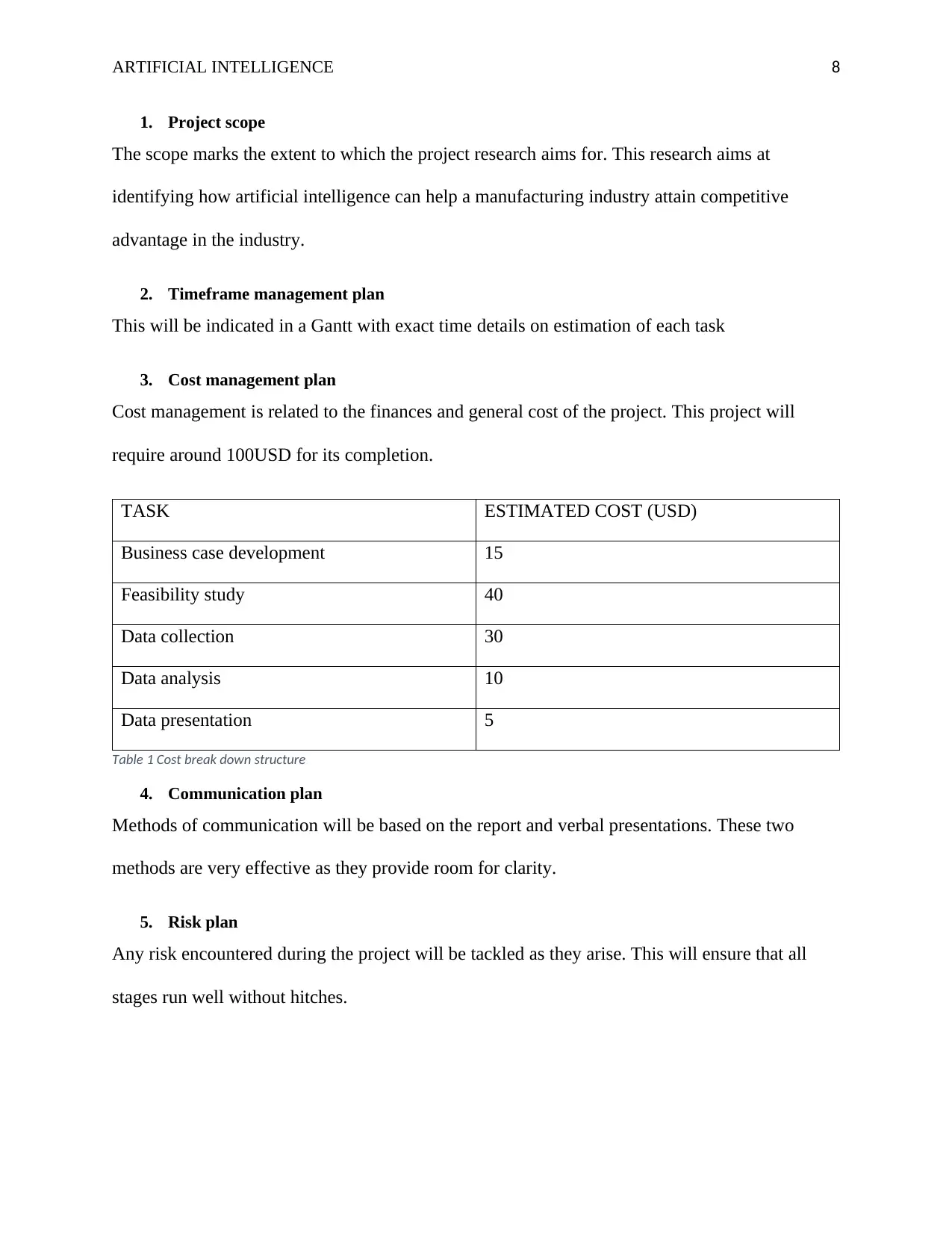
ARTIFICIAL INTELLIGENCE 8
1. Project scope
The scope marks the extent to which the project research aims for. This research aims at
identifying how artificial intelligence can help a manufacturing industry attain competitive
advantage in the industry.
2. Timeframe management plan
This will be indicated in a Gantt with exact time details on estimation of each task
3. Cost management plan
Cost management is related to the finances and general cost of the project. This project will
require around 100USD for its completion.
TASK ESTIMATED COST (USD)
Business case development 15
Feasibility study 40
Data collection 30
Data analysis 10
Data presentation 5
Table 1 Cost break down structure
4. Communication plan
Methods of communication will be based on the report and verbal presentations. These two
methods are very effective as they provide room for clarity.
5. Risk plan
Any risk encountered during the project will be tackled as they arise. This will ensure that all
stages run well without hitches.
1. Project scope
The scope marks the extent to which the project research aims for. This research aims at
identifying how artificial intelligence can help a manufacturing industry attain competitive
advantage in the industry.
2. Timeframe management plan
This will be indicated in a Gantt with exact time details on estimation of each task
3. Cost management plan
Cost management is related to the finances and general cost of the project. This project will
require around 100USD for its completion.
TASK ESTIMATED COST (USD)
Business case development 15
Feasibility study 40
Data collection 30
Data analysis 10
Data presentation 5
Table 1 Cost break down structure
4. Communication plan
Methods of communication will be based on the report and verbal presentations. These two
methods are very effective as they provide room for clarity.
5. Risk plan
Any risk encountered during the project will be tackled as they arise. This will ensure that all
stages run well without hitches.
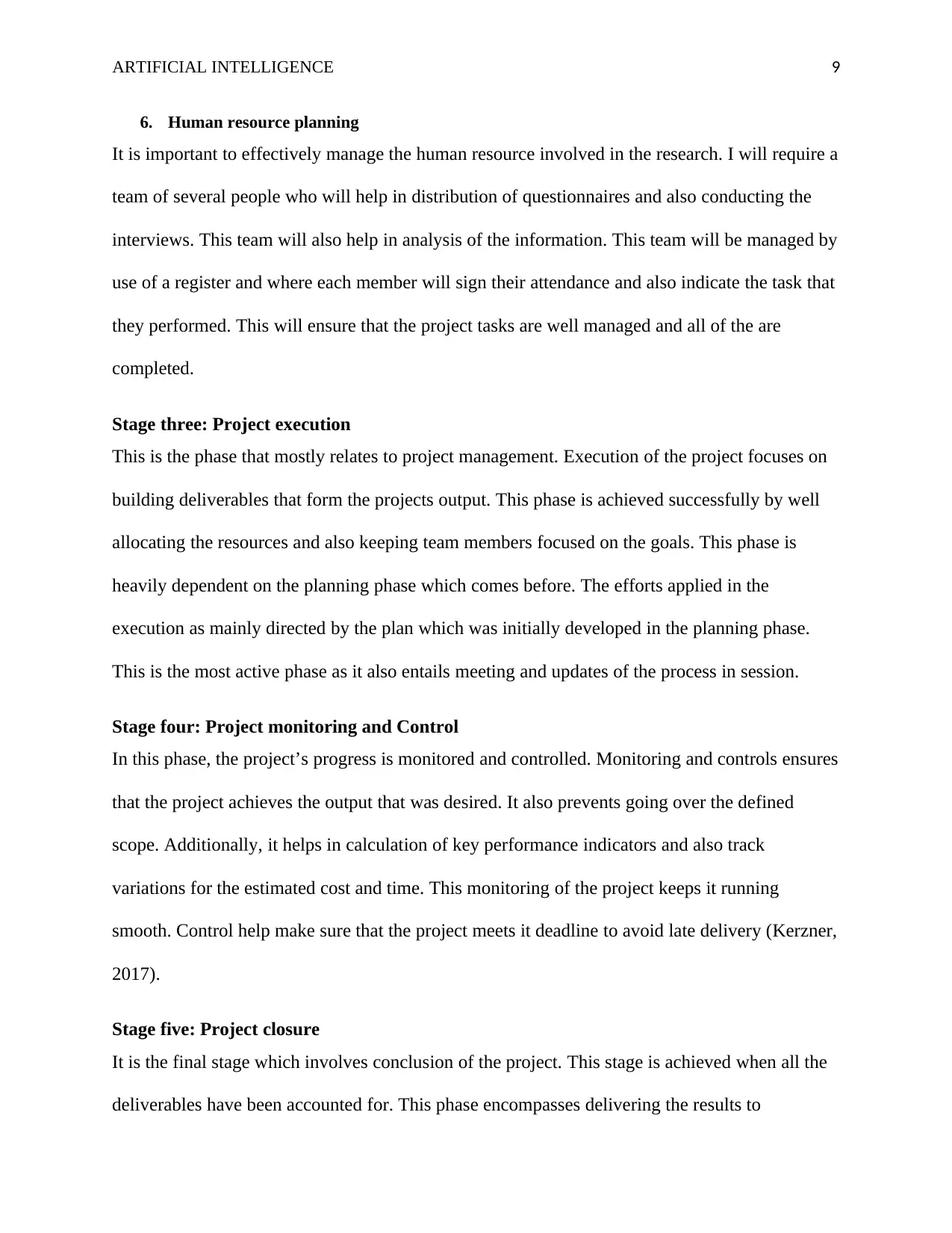
ARTIFICIAL INTELLIGENCE 9
6. Human resource planning
It is important to effectively manage the human resource involved in the research. I will require a
team of several people who will help in distribution of questionnaires and also conducting the
interviews. This team will also help in analysis of the information. This team will be managed by
use of a register and where each member will sign their attendance and also indicate the task that
they performed. This will ensure that the project tasks are well managed and all of the are
completed.
Stage three: Project execution
This is the phase that mostly relates to project management. Execution of the project focuses on
building deliverables that form the projects output. This phase is achieved successfully by well
allocating the resources and also keeping team members focused on the goals. This phase is
heavily dependent on the planning phase which comes before. The efforts applied in the
execution as mainly directed by the plan which was initially developed in the planning phase.
This is the most active phase as it also entails meeting and updates of the process in session.
Stage four: Project monitoring and Control
In this phase, the project’s progress is monitored and controlled. Monitoring and controls ensures
that the project achieves the output that was desired. It also prevents going over the defined
scope. Additionally, it helps in calculation of key performance indicators and also track
variations for the estimated cost and time. This monitoring of the project keeps it running
smooth. Control help make sure that the project meets it deadline to avoid late delivery (Kerzner,
2017).
Stage five: Project closure
It is the final stage which involves conclusion of the project. This stage is achieved when all the
deliverables have been accounted for. This phase encompasses delivering the results to
6. Human resource planning
It is important to effectively manage the human resource involved in the research. I will require a
team of several people who will help in distribution of questionnaires and also conducting the
interviews. This team will also help in analysis of the information. This team will be managed by
use of a register and where each member will sign their attendance and also indicate the task that
they performed. This will ensure that the project tasks are well managed and all of the are
completed.
Stage three: Project execution
This is the phase that mostly relates to project management. Execution of the project focuses on
building deliverables that form the projects output. This phase is achieved successfully by well
allocating the resources and also keeping team members focused on the goals. This phase is
heavily dependent on the planning phase which comes before. The efforts applied in the
execution as mainly directed by the plan which was initially developed in the planning phase.
This is the most active phase as it also entails meeting and updates of the process in session.
Stage four: Project monitoring and Control
In this phase, the project’s progress is monitored and controlled. Monitoring and controls ensures
that the project achieves the output that was desired. It also prevents going over the defined
scope. Additionally, it helps in calculation of key performance indicators and also track
variations for the estimated cost and time. This monitoring of the project keeps it running
smooth. Control help make sure that the project meets it deadline to avoid late delivery (Kerzner,
2017).
Stage five: Project closure
It is the final stage which involves conclusion of the project. This stage is achieved when all the
deliverables have been accounted for. This phase encompasses delivering the results to
⊘ This is a preview!⊘
Do you want full access?
Subscribe today to unlock all pages.

Trusted by 1+ million students worldwide
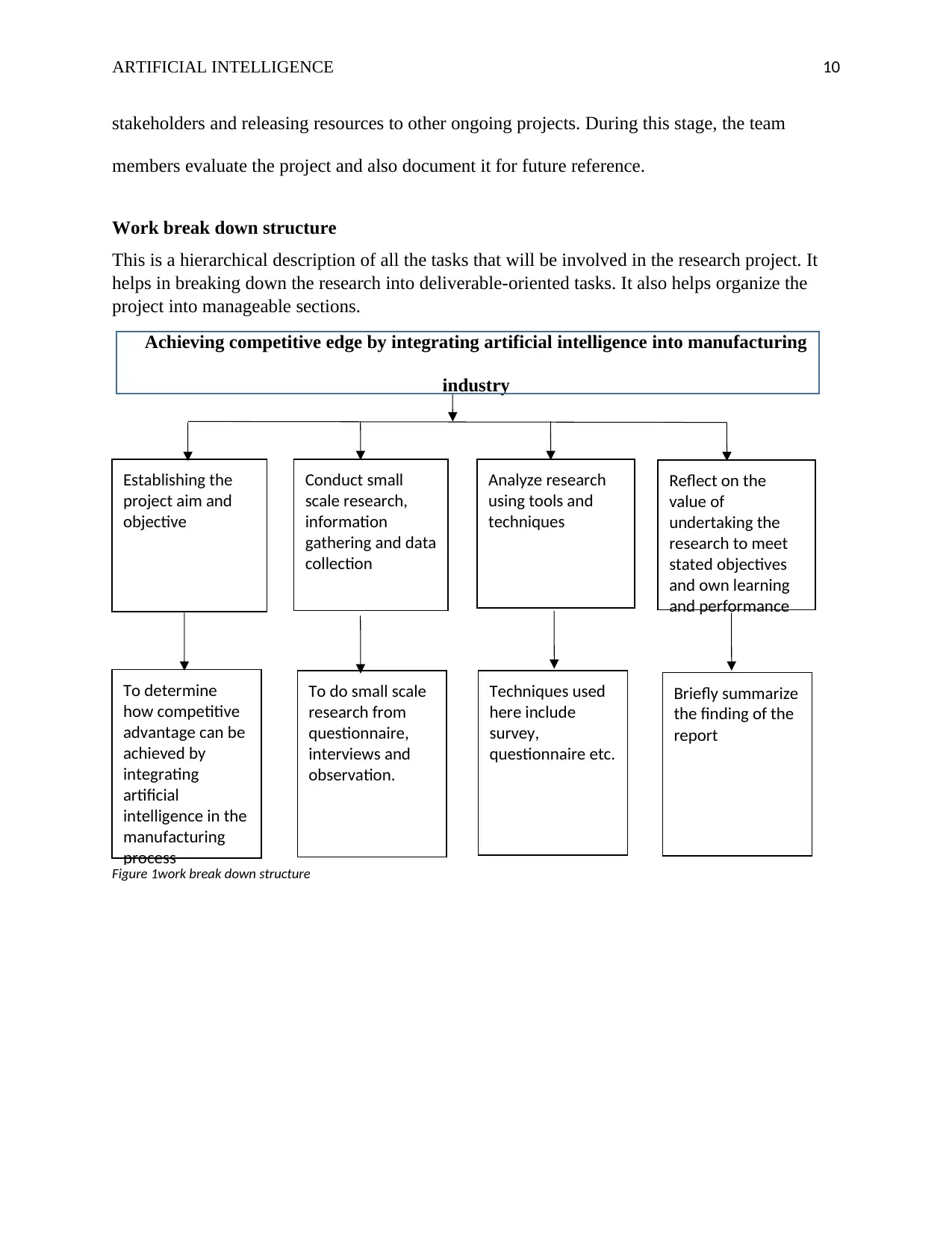
ARTIFICIAL INTELLIGENCE 10
stakeholders and releasing resources to other ongoing projects. During this stage, the team
members evaluate the project and also document it for future reference.
Work break down structure
This is a hierarchical description of all the tasks that will be involved in the research project. It
helps in breaking down the research into deliverable-oriented tasks. It also helps organize the
project into manageable sections.
Achieving competitive edge by integrating artificial intelligence into manufacturing
industry
Establishing the
project aim and
objective
Conduct small
scale research,
information
gathering and data
collection
Analyze research
using tools and
techniques
Reflect on the
value of
undertaking the
research to meet
stated objectives
and own learning
and performance
To determine
how competitive
advantage can be
achieved by
integrating
artificial
intelligence in the
manufacturing
process
To do small scale
research from
questionnaire,
interviews and
observation.
Techniques used
here include
survey,
questionnaire etc.
Briefly summarize
the finding of the
report
Figure 1work break down structure
stakeholders and releasing resources to other ongoing projects. During this stage, the team
members evaluate the project and also document it for future reference.
Work break down structure
This is a hierarchical description of all the tasks that will be involved in the research project. It
helps in breaking down the research into deliverable-oriented tasks. It also helps organize the
project into manageable sections.
Achieving competitive edge by integrating artificial intelligence into manufacturing
industry
Establishing the
project aim and
objective
Conduct small
scale research,
information
gathering and data
collection
Analyze research
using tools and
techniques
Reflect on the
value of
undertaking the
research to meet
stated objectives
and own learning
and performance
To determine
how competitive
advantage can be
achieved by
integrating
artificial
intelligence in the
manufacturing
process
To do small scale
research from
questionnaire,
interviews and
observation.
Techniques used
here include
survey,
questionnaire etc.
Briefly summarize
the finding of the
report
Figure 1work break down structure
Paraphrase This Document
Need a fresh take? Get an instant paraphrase of this document with our AI Paraphraser
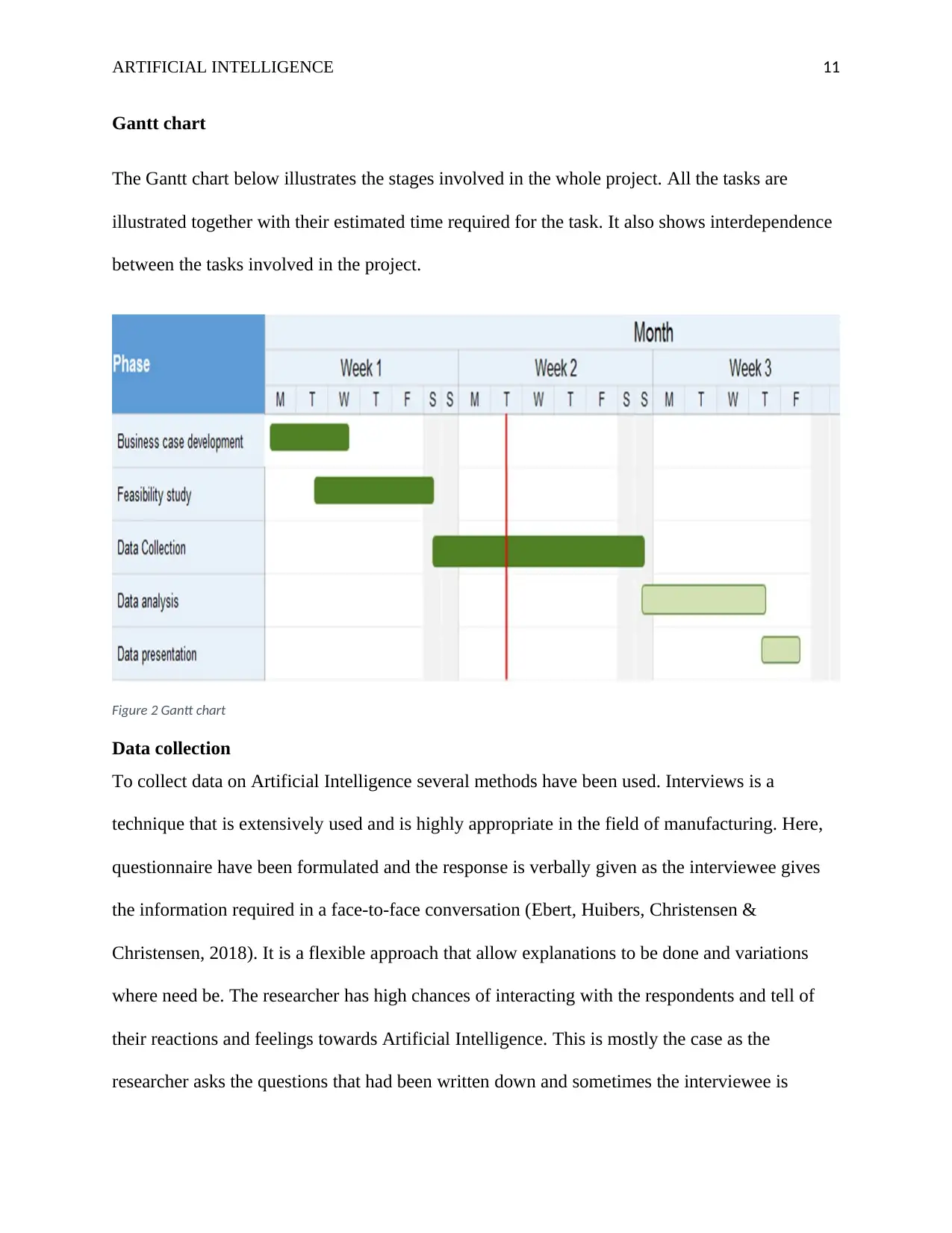
ARTIFICIAL INTELLIGENCE 11
Gantt chart
The Gantt chart below illustrates the stages involved in the whole project. All the tasks are
illustrated together with their estimated time required for the task. It also shows interdependence
between the tasks involved in the project.
Figure 2 Gantt chart
Data collection
To collect data on Artificial Intelligence several methods have been used. Interviews is a
technique that is extensively used and is highly appropriate in the field of manufacturing. Here,
questionnaire have been formulated and the response is verbally given as the interviewee gives
the information required in a face-to-face conversation (Ebert, Huibers, Christensen &
Christensen, 2018). It is a flexible approach that allow explanations to be done and variations
where need be. The researcher has high chances of interacting with the respondents and tell of
their reactions and feelings towards Artificial Intelligence. This is mostly the case as the
researcher asks the questions that had been written down and sometimes the interviewee is
Gantt chart
The Gantt chart below illustrates the stages involved in the whole project. All the tasks are
illustrated together with their estimated time required for the task. It also shows interdependence
between the tasks involved in the project.
Figure 2 Gantt chart
Data collection
To collect data on Artificial Intelligence several methods have been used. Interviews is a
technique that is extensively used and is highly appropriate in the field of manufacturing. Here,
questionnaire have been formulated and the response is verbally given as the interviewee gives
the information required in a face-to-face conversation (Ebert, Huibers, Christensen &
Christensen, 2018). It is a flexible approach that allow explanations to be done and variations
where need be. The researcher has high chances of interacting with the respondents and tell of
their reactions and feelings towards Artificial Intelligence. This is mostly the case as the
researcher asks the questions that had been written down and sometimes the interviewee is
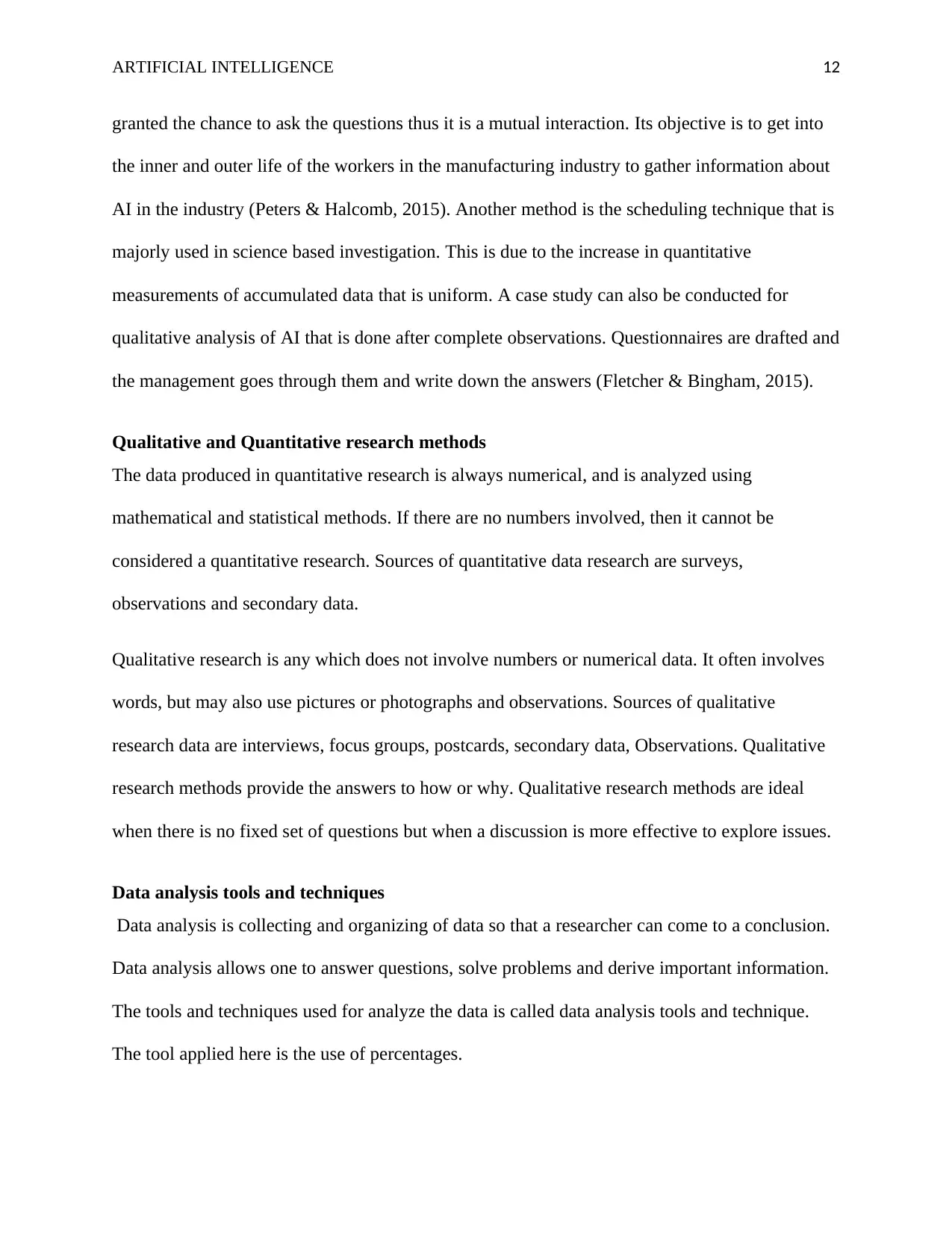
ARTIFICIAL INTELLIGENCE 12
granted the chance to ask the questions thus it is a mutual interaction. Its objective is to get into
the inner and outer life of the workers in the manufacturing industry to gather information about
AI in the industry (Peters & Halcomb, 2015). Another method is the scheduling technique that is
majorly used in science based investigation. This is due to the increase in quantitative
measurements of accumulated data that is uniform. A case study can also be conducted for
qualitative analysis of AI that is done after complete observations. Questionnaires are drafted and
the management goes through them and write down the answers (Fletcher & Bingham, 2015).
Qualitative and Quantitative research methods
The data produced in quantitative research is always numerical, and is analyzed using
mathematical and statistical methods. If there are no numbers involved, then it cannot be
considered a quantitative research. Sources of quantitative data research are surveys,
observations and secondary data.
Qualitative research is any which does not involve numbers or numerical data. It often involves
words, but may also use pictures or photographs and observations. Sources of qualitative
research data are interviews, focus groups, postcards, secondary data, Observations. Qualitative
research methods provide the answers to how or why. Qualitative research methods are ideal
when there is no fixed set of questions but when a discussion is more effective to explore issues.
Data analysis tools and techniques
Data analysis is collecting and organizing of data so that a researcher can come to a conclusion.
Data analysis allows one to answer questions, solve problems and derive important information.
The tools and techniques used for analyze the data is called data analysis tools and technique.
The tool applied here is the use of percentages.
granted the chance to ask the questions thus it is a mutual interaction. Its objective is to get into
the inner and outer life of the workers in the manufacturing industry to gather information about
AI in the industry (Peters & Halcomb, 2015). Another method is the scheduling technique that is
majorly used in science based investigation. This is due to the increase in quantitative
measurements of accumulated data that is uniform. A case study can also be conducted for
qualitative analysis of AI that is done after complete observations. Questionnaires are drafted and
the management goes through them and write down the answers (Fletcher & Bingham, 2015).
Qualitative and Quantitative research methods
The data produced in quantitative research is always numerical, and is analyzed using
mathematical and statistical methods. If there are no numbers involved, then it cannot be
considered a quantitative research. Sources of quantitative data research are surveys,
observations and secondary data.
Qualitative research is any which does not involve numbers or numerical data. It often involves
words, but may also use pictures or photographs and observations. Sources of qualitative
research data are interviews, focus groups, postcards, secondary data, Observations. Qualitative
research methods provide the answers to how or why. Qualitative research methods are ideal
when there is no fixed set of questions but when a discussion is more effective to explore issues.
Data analysis tools and techniques
Data analysis is collecting and organizing of data so that a researcher can come to a conclusion.
Data analysis allows one to answer questions, solve problems and derive important information.
The tools and techniques used for analyze the data is called data analysis tools and technique.
The tool applied here is the use of percentages.
⊘ This is a preview!⊘
Do you want full access?
Subscribe today to unlock all pages.

Trusted by 1+ million students worldwide
1 out of 20
Your All-in-One AI-Powered Toolkit for Academic Success.
+13062052269
info@desklib.com
Available 24*7 on WhatsApp / Email
![[object Object]](/_next/static/media/star-bottom.7253800d.svg)
Unlock your academic potential
Copyright © 2020–2025 A2Z Services. All Rights Reserved. Developed and managed by ZUCOL.

